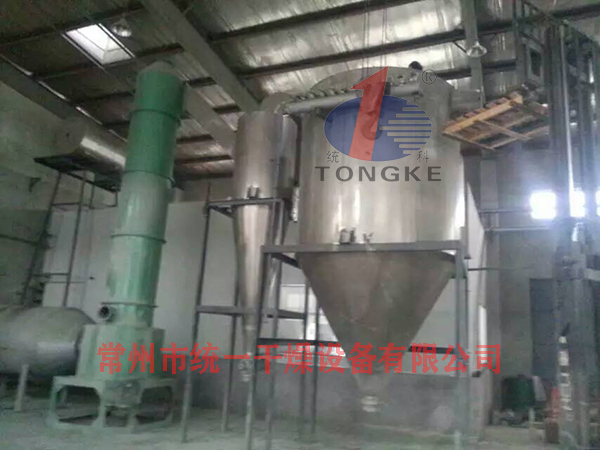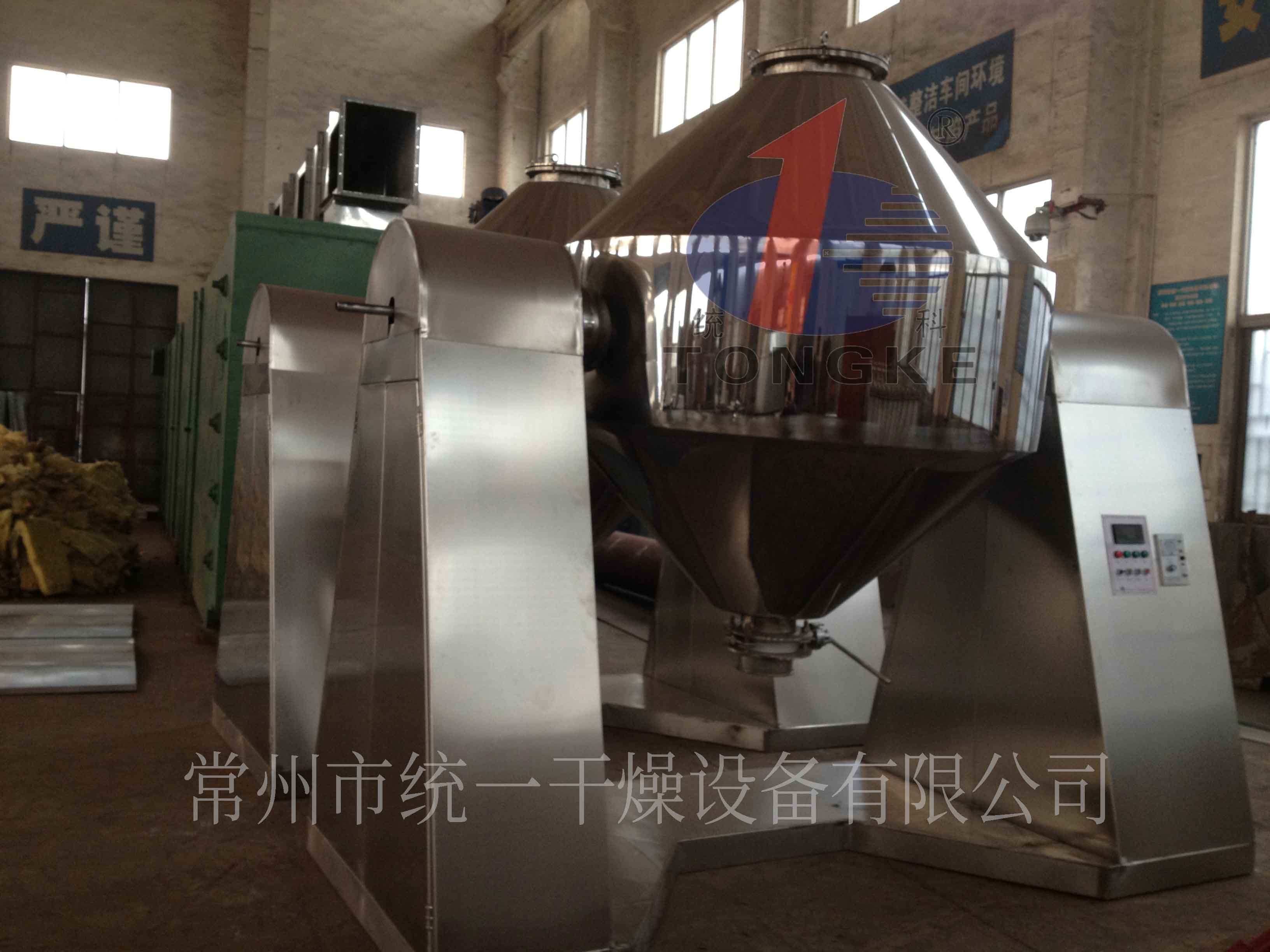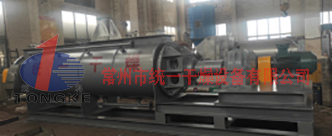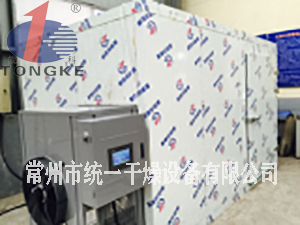美国Komline-Sanderson桨叶干燥机
信息来源: | 发布日期: 2013-03-06 00:00:00 | 浏览量:649142
桨叶干燥机/处理器是高效机械搅拌,间接传热设备,添加或删除热量的过程质量。他们用于干燥,加热,冷却,巴氏灭菌法,结晶,和糊剂,蛋糕,粉剂,和粒剂的反应...
Komline-Sanderson桨叶干燥机/处理器是高效机械搅拌,间接传热设备,添加或删除热量的过程质量。他们用于干燥,加热,冷却,巴氏灭菌法,结晶,和糊剂,蛋糕,粉剂,和粒剂的反应。
具有独特的啮合楔形状桨双反旋转轴产生均匀混合,优化传热。使用空心桨叶传热结果,在一个紧凑的机器。的传热介质:蒸汽,油,热流体,水,或乙二醇中分离从过程的质量。
Komline-Sanderson提供蒸气紧的挥发性有机化合物(VOCs)或其它有害物质的应用程序的设计。温度敏感的材料,可以在低的温度下在真空下干燥。
应用
烘干
KS桨叶干燥机间接加热用蒸汽或热流体(热油)。这提供了高能源效率和低废气量。^多到750°F的传热介质都可以使用。可以采用热吹扫气,以防止冷凝的蒸气空间或干燥机的下游。
干燥到低含水量或10ppm或更低的残留溶剂水平,需要均匀地加热和停留时间。 KS桨叶干燥机可让您达到这些目标的一个持续的过程。
KS桨叶干燥机干燥浆料提供了一个可靠和有效的方法,滤饼和离心浓缩。真空的设计可以在减压下除去水或有机溶剂。
暖气
加热熔化,烹饪,杀菌,烘焙或反应过程质量。加热介质可以是蒸汽,热油或热水。两区的设计允许两个不同的温度区。
冷却
移除热量从用冷水或热流体(丙二醇,下降至-40°F)的处理质量。冷却,可以在受控的不含水分的环境。两区的设计允许两个不同的温度区。
煅烧
热油可用于煅烧在温度高达700°F。高温煅烧前的水蒸发,将增加的高温设备的能力,以及该过程的热效率。
反应
^的温度和停留时间的控制允许对KS桨叶处理器被用于催化和控制反应。它可用于放热和吸热反应。高程度的混合,允许多个成分充分混合作为反应过程的一部分。
结晶
选择性聚合物结晶或结晶在控制的速率和温度,可以实现使用的KS桨叶处理器。
加工的材料包括:
化学方法:盐,催化剂,溴化有机物,纤维素,淀粉
石油化工:固体devolatization
聚合物和塑料:聚丙烯,聚碳酸酯,聚苯硫醚,PET,PTA
面粉食品,饮料粉,糖果配料,肉类产品
矿物和金属:金属粉末,金属碳酸盐,硫酸盐和氢氧化物
优点
热效率高。
传热介质不接触的产品。
气体不被用于传达产品。截断气体流量是^小的。
^的温度控制
统一的产品质量,通过混合和运动的产品
一次通过的基础上持续的过程
高传热面积,处理体积比 - 建筑面积减少
预调节与循环的通常不是必需的。
操作简单,需要很少的注意
安全比直接干燥处理易燃材料时,
简单耐用的设计简单,维护成本低
封闭过程中包含的气味和有害物质
设计
传热面积从20到超过3300平方米英尺(5.6到305平方米)的每机
加热用蒸汽或热流体(热油)
冷却水或水 - 乙二醇混合物
用于双温区设计独特的应用
设计,建造,并加盖按照ASME规范或PED
可调工作水平的提高过程的灵活性(回合)
碳钢,不锈钢或合金的过程中的接触面
表面光洁度满足工艺要求(从磨电抛光)
耐磨涂料在选定的地区
在操作过程中的惰性过程
坚固耐用的设计,专为高扭矩,低运行速度
轴,带座轴承,传动部件,寿命长,是专为在恶劣的条件下,确保长期的机械完整性
Komline-Sanderson桨叶干燥机/处理器是一种高效,机械搅拌,间接传热设备热添加或删除一个过程质量。双计数器具有独特的相互啮合的楔形桨叶的旋转轴产生紧密的混合,均匀传热,高传热率,和一个自清洁效果。无定子线棒(断路器条)是必要的。
一个大的传热面积与体积之比来实现所使用的空心桨叶和一个带夹套的容器中,通过该加热介质的流动。其结果是一个紧凑的机器,用更少的空间要求和降低了安装成本。
的金属壁分离的过程的质量,从传热介质。得到的,因为是通过传导传热,热效率高。失去的热量很少用绝缘机。
KS桨干燥器输送材料,无论其处理特性。粘性,膏状物料运输。预调节的饲料混合,与回收的干燥产物,以使它能传输,不是必需的。这将导致较低的资本,运营和维护成本。
材料是通过KS桨叶干燥机输送排量(“活塞流”)。作为材料被添加到进料端,它被同化进入床层,通过搅拌器的混合作用。水头压力,结合的楔形桨叶与行动,推压材料的周围,并通过桨叶。由于该产品通过位移移动,停留时间被控制的进给速率和溢流堰的高度。
KS桨叶干燥机的设计与高扭矩能力,以增加其过程的灵活性。额外的扭矩让你上线,在异常条件下的发展。
由于KS桨烘干机是间接加热的排出气体的量是^小的。通常情况下,没有外部的吹扫气体是必需的。对于某些应用吹扫气体被用于增加的干燥速率,或以防止冷凝的冷却器或蒸汽出口的干燥器。伴热盖也可以做,以避免结露现象发生。
系统
KS过程和项目工程师在项目的所有阶段提供援助。 KS可以根据您的具体要求,为您提供一个机/处理器,或一个完整的系统。
一个成功的工厂取决于选择合适的辅助设备和合适的设备设计与整合的关键工序单位。可靠性,操作方便,坚固的结构,性能和卓越的客户服务的KS安装所有的商标。
一个典型的系统包括一个进料计量装置,如一个可变速度的输送机或泵。进料计量是过程控制的重要组成部分。
在大多数应用中的截断气体的量是非常低的,在低的温度下。当使用吹扫气体,堪萨斯扫描空调可以集成到系统中。
安全功能必须是系统设计的一部分。 KS桨烘干机用一种惰性的低温度环境操作。空气不被用于传达一种在干燥机中的热产物。截断气体被冷凝挥发物后,可以回收。
必要时,爆炸抑制系统或爆燃通风板纳入干燥器的盖。惰用氮气的过程,也可以完成与一个^小吹扫速率。
蒸气紧缩的设计允许的处理的材料含有有机溶剂和安全的方式在一个封闭的有害材料。热敏感的材料也可以用在低的温度下在真空下使用热水作为加热介质。
常见问题
K-S桨叶干燥机的效率如何?
一种间接加热,以及绝缘,桨机/处理器具有一个约98%的热效率。
干燥需要多少能量?
为KS桨烘干机所需的能量的量是依赖于初始水分和的^终湿度以及饲料和放电的温度。
例如:本机需要1155 BTU每磅水去除干燥的材料从20%90%DS DS。这是在干燥器“热负荷”。要计算燃油成本,失去了在锅炉或热流体加热器,线失去了你需要的因素。例如,蒸汽锅炉一般是80%的效率,而热流体加热器的效率范围为83%〜87%取决于设计。
机/处理器大小如何?
每小时的进给速率被建立,和从该总热负荷(Q)被确定。的加热/冷却介质的温度建立对数平均温度差(驱动力,LMTD)。的传热系数(U)是依赖于被加工的材料。这是通过使用从以前的经验和测试数据的数据建立。在这些价值观的建立了传热面积(A)的计算方法是:
A = Q /(U X LMTD)
什么样的蒸汽压力是必需的?热流体温度,该怎么办?
对于大多数材料的干燥,加热介质的温度为380〜400°F的使用。对于热敏感材料,使用低得多的温度下。对于干燥的惰性材料高得多的可用于加热介质的温度(高达750°F)。
K-S提供实验室和中试吗?
是的,KS可以在我们的技术中心或在您的工厂提供试验性测试。在我们的测试计划是在“参考文献”提供的信息。
The Komline-Sanderson Paddle Dryer / Processor are highly efficient, mechanically agitated, indirect heat transfer devices that add or remove heat from a process mass. They are used for drying, heating, cooling, pasteurization, crystallizing, and reacting of pastes, cakes, powders, and granules.
Dual counter-rotating shafts with unique intermeshing wedge shape paddles produce intimate mixing and optimize heat transfer. The use of hollow paddles for heat transfer results in a compact machine. The heat transfer medium: steam, oil, thermal fluid, water, or glycol is isolated from the process mass.
Komline-Sanderson offers vapor tight designs for applications with volatile organic compounds (VOCs) or hazardous materials. Temperature sensitive materials can be dried at low temperatures under vacuum.
Applications
Drying
The K-S Paddle Dryer is indirectly heated with steam or thermal fluid (hot oil). This provides for high energy efficiencies and low off-gas volumes. Heat transfer mediums of up to 750 °F can be used. Hot sweep gas can be employed to prevent condensation in the vapor space or downstream of the dryer.
Drying to low moistures or residual solvents levels of 10 ppm or lower requires uniform heating and residence time. The K-S Paddle Dryer allows you to reach these objectives with a continuous process.
The K-S Paddle Dryer provides a reliable and efficient method for drying slurry, filter cakes and centrifuge concentrates. Vacuum designs can remove water or organic solvents at reduced temperatures.
Heating
Heating a process mass for melting, cooking, pasteurization, roasting or reacting. The heating medium can be steam, hot oil, or hot water. Two- zone design allows for two distinct temperature zones.
Cooling
Remove heat from a process mass with cold water or thermal fluid (glycol, down to -40 °F). Cooling can be done in a controlled moisture-free environment. Two- zone design allows for two distinct temperature zones.
Calcining
Hot oil can be used for calcining at temperatures up to 700 °F. Evaporation of water prior to high temperature calcining will increase the capacity of the high temperature equipment, and the thermal efficiency of the process.
Reacting
Precise temperature and residence time control allows the K-S Paddle Processor to be used for catalyzing and controlling reactions. It can be used for both exothermic and endothermic reactions. A high degree of mixing allows multiple ingredients to be thoroughly mixed as part of the reacting process.
Crystallizing
Selective polymer crystallization or crystallizing at controlled rates and temperature can be achieved by using the K-S Paddle Processor.
Materials processed include:
Chemical: salts, catalyst, brominated organics, cellulose, starch
Petrochemical: solids devolatization
Polymer and plastic: polypropylene, polycarbonate, polyphenylsulfide, PET, PTA
Food: flour, beverage powders, confectionary ingredients, meat products
Mineral and metal: metal powders, metal carbonates, sulfates and hydroxides
Benefits
High thermal efficiency
Heat transfer medium does not contact the product.
Gas is not used to convey the product. Off-gas flow is minimal.
Precise control of temperature
Uniform product quality, through mixing and movement of the product
Continuous process on a once-through basis
High heat transfer area to process volume ratio - reduced floor space
Pre-conditioning with recycle is typically not required.
Easy to operate, requires minimal attention
Safer than direct drying when processing combustible material
Simple durable design for easy and low maintenance
Enclosed process contains odors and hazardous materials
Design
Heat transfer areas from 20 to over 3300 square feet (5.6 to over 305 square metres) per dryer
Heated with steam or thermal fluid (hot oil)
Cooled with water or water-glycol mixtures
Two temperature-zone design used for unique applications
Designed, constructed, and stamped per ASME Code or PED
Adjustable operating level increases process flexibility (turn-down)
Process contact surfaces of carbon steel, stainless steel or alloy
Surface finishes to meet process requirements (from mill to electro-polished)
Available with abrasion-resistant coatings on selected areas
Inert process during operation
Robust design, designed for high torque and low operating speed
Shafts, pillow block bearings, and drive components are designed for long life under adverse conditions, insuring long-term mechanical integrity
The Komline-Sanderson Paddle Dryer / Processor are a highly efficient, mechanically agitated, indirect heat transfer devices for adding or removing heat from a process mass. Dual counter-rotating shafts with unique intermeshing wedge-shaped paddles produce intimate mixing, uniform heat transfer, a high heat transfer rate, and a self-cleaning effect. No stator bars (breaker bars) are needed.
A large heat transfer area to volume ratio is achieved by the use of hollow paddles and a jacketed vessel, through which the heating medium flows. The result is a compact machine with less space requirements and lower installation cost.
A metal wall separates the process mass from the heat transfer medium. High thermal efficiency is obtained because the heat transfer is by conduction. Very little heat is lost with an insulated dryer.
The K-S Paddle Dryer transports material, regardless of its handling characteristics. Sticky, pasty materials can be transported. Pre-conditioning the feed by mixing with recycled dried product, to make it conveyable, is not required. This results in lower capital, operating, and maintenance cost.
Material is conveyed through the K-S Paddle Dryer by displacement (“piston flow”). As material is added to the feed end, it is assimilated into the bed by the mixing action of the agitators. Hydraulic head pressure, combined with the action of the wedge-shaped paddles, pushes material around and through the paddles. Since the product moves by displacement, residence time is controlled by the feed rate and the overflow weir height.
The K-S Paddle Dryer is designed with high torque capabilities to increase its process flexibility. Extra torque keeps you on-line, when upset conditions develop.
Because the K-S Paddle Dryer is indirectly heated the amount of off-gas is minimal. Typically no external sweep gas is required. For certain applications sweep gas is used to increase the drying rate or to prevent condensation in a cooler or the vapor outlet of a dryer. Heat tracing the cover can also be done to prevent condensation from occurring.
System
K-S process and project engineers provide assistance at all phases of the project. Depending on your specific requirements, K-S can provide you with a dryer/processor, or a complete system.
A successful plant depends on the integration of the key process units with properly selected ancillary equipment and the right facility design. Reliability, ease of operation, rugged construction, performance, and the superior customer service are all trademarks of a K-S installation.
A typical system includes a feed metering device such as a variable speed conveyor or pump. Feed metering is an important part of process control.
In most applications the off-gas volume is very low and at a low temperature. When sweep gas is used, K-S can integrate sweep air conditioning into the system.
Safety features must be part of the system design. The K-S Paddle Dryer operates with an inert low temperature environment. Air is not used to convey a hot product in the dryer. Off-gas can be recycled after volatiles are condensed.
When necessary, explosion suppression systems or deflagration vent panels are incorporated into the dryer’s cover. Inerting of the process with nitrogen can also be accomplished with a minimal purge rate.
Our vapor tight design allows for the processing of material containing organic solvents and hazardous materials in an enclosed safe manner. Heat sensitive materials can also be dried at low temperatures under vacuum using hot water as the heating medium.
FAQs
How efficient is the K-S Paddle Dryer?
An indirectly heated, well insulated, Paddle Dryer / Processor has a thermal efficiency of approximately 98%.
How much energy is needed for drying?
The amount of energy required for the K-S Paddle Dryer is dependent on the initial moisture and the final moisture as well as the feed and discharge temperatures.
Example: Our dryer needs 1155 BTU per pound of water removed to dry material from 20% ds to 90% ds. This is the “heat load” at the dryer. To calculate the fuel cost, you need to factor in loses at the boiler or thermal fluid heater and line loses. For example, a steam boiler is typically 80% efficient while a thermal fluid heater’s efficiency ranges from 83% to 87% depending on design.
How is the dryer/processor sized?
The hourly feed rate is established and from this the total heat load (Q) is determined. The heating/cooling medium temperature establishes the log mean temperature differential (driving force, LMTD). The heat transfer coefficient (U) is dependent on the material being processed. This is established by using data from prior experience and test data. With these values established the heat transfer area (A) is calculated by:
A = Q/(U x LMTD)
What steam pressure is required? What thermal fluid temperature is used?
For drying of most materials, a heating medium temperature of 380 to 400 °F is used. For heat sensitive materials, much lower temperatures are used. For drying of inert materials much higher heating medium temperatures can be used (up to 750 °F).
Does K-S offer lab and pilot test?
Yes, K-S can provide pilot testing at our Technical Center or at your plant. Information on our test programs is provided in “References”.
-
2024-03-11 16:00:12
大型离心喷雾应用于药渣废液环保项目
-
2023-12-22 22:11:04
专用电池材料振动真空干燥机
-
2023-12-22 22:06:21
废盐专用连续式卧式沸腾床
-
2023-12-22 22:04:19
电磁高温固化及反应干燥装备
-
2023-12-22 22:02:33
高效节能高温耐热材料隧道窑炉
-
2023-12-22 21:56:06
药厂菌渣废液大型离心喷雾干燥按期交货






